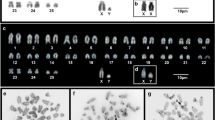Abstract
G-banding comparisons of 26 species in 10 genera of three tribes of Australian rodents show that at least one representative of each of the three tribes has autosomal complements that are indistinguishable on G-banding, implying unusually high conservation of karyotypes. Three genera (Pseudomys, Notomys, and Mastacomys) are distinguished karyotypically by a reciprocal translocation, one genus (Uromys) by a tandem fusion, and one genus (Zyzomys) by a radically altered karyotype. The only other rearrangements identified from G-banding are pericentric inversions, all 12 of which involve breaks in the proximal area.
Similar content being viewed by others
References
Baker, R. J. & Bickham, J. W., 1980. Karyotypic evolution in bats: evidence of extensive and conservative chromosomal evolution in closely related taxa. Syst. Zool. 29: 239–253.
Baverstock, P. R., Hogarth, J. T., Cole, S. & Covacevich, J., 1976a. Biochemical and karyotypie evidence for the specifie status of the rodent Leggadina lakedownensis Watts, 1976. Trans. R. Soc. S. Aust. 100: 109–112.
Baverstock, P. R., Watts, C. H. S. & Hogarth, J. T., 1976b, Heterochromatin variation in the Australian rodent Uromys caudimaculatus. Chromosoma 57: 397–403.
Baverstock, P. R., Watts, C. H. S. & Hogarth, J. T., 1977a, Chromosome evolution in Australian rodents I. The Pseudomylnae, the Hydromyinae and the Uromys/Melomys group. Chromosoma 61: 95–125.
Baverstock, P. R., Watts, C. H. S., Hogarth, J. T., Robinson, A. C. & Robinson, J. F., 1977b. Chromosome evolution in Australian rodents II. The Rattus group. Chromosoma 61: 227–241.
Baverstock, P. R., Watts, C. H. S. & Hogarth, J. T., 1977c. Polymorphic patterns of heterochromatin distribution in Australian hopping mice, Notomys alexis, N. cervinus and N. fuscus (Rodentia, Muridae). Chromosoma 61: 243–256.
Baverstock, P. R., Watts, C. H. S. & Cole, S. R., 1977d. Electrophoretic comparisons between allopatric populations of five Australian Pseudomyine rodents (Muridae). Aust. J. Biol. Sci. 30: 471–485.
Baverstock, P. R., Watts, C. H. S., Adams, M. & Cole, S. R., 1981. Genetical relationships among Australian rodents (Muridae). Aust. J. Zool. 29: 283–303.
Baverstock, P. R., Gelder, M. & Jahnke, A., 1982. Cytogenetic studies of the Australian rodent, Uromys caudimaculatus, a species showing extensive heterochromatin variation. Chromosoma 84: 517–533.
Baverstock, P. R., Gelder, M. & Jahnke, A., 1983. Chromosome evolution in Australian Rattus-G-banding and hybrid meiosis. Genetica 60: 93–103.
Chandley, A. C., Seuanez, H. & Fletcher, J. M., 1976. Meiotic behaviour of five human reciprocal translocations. Cytogenet. Cell Genet. 17: 98–111.
Elder, F. F. B., 1980. Tandem fusion, centric fusion, and chromosomal evolution in the cotton rats, genus Sigmodon. Cytogenet. Cell Genet. 26: 199–210.
Lande, R., 1979. Effective deme sizes during long-term evolution estimated from rates of chromosomal rearrangement. Evolution 33: 234–251.
Lee, A. K., Baverstock, P. R. & Watts, C. H. S., 1981. Rodents-the late invaders. In: Ecological biogeography of Australia (A. Keast, ed.) The Hague: Junk.
Musser, G. G., 1981. The giant rat of Flores and its relatives east of Borneo and Ball. Bull. Am. Mus. nat. Hist. 169: 71–175.
Madan, K., Ford, C. E. & Polge, C., 1978. A reciprocal translocation, t(6p+; 14q-), in the pig. J. Repord. Fert. 53: 395–398.
Rofe, R. H., 1979. G-banding and chromosomal evolution in Australian marsupials. Unpubl. Ph.D. thesis, Univ. Adelaide.
Rumpler, Y. & Dutrillaux, B., 1978. Chromosomal evolution in Malagasy lemurs III. Chromosome banding studies in the genus Hapalemur and the species Lemur catta. Cytogenet. Cell Genet. 21: 201–211.
Seabright, M., 1972. The use of proteolytic enzymes for the mapping of structural rearrangements in the chromosomes of man. Chromosoma 26: 204–211.
Shi, Li Ming, Ye, Ying Ying & Duan, Xingsheng, 1980. Comparative cytogenetic studies on the red muntjac, Chinese muntjac, and their F1 hybrids. Cytogenet. Cell. Genet. 26: 22–27.
Simpson, G. G., 1961. Zoogeography of Australian mammals. Evolution 15: 431–436.
Stock, A. D. & Hsu, T. C., 1973. Evolutionary conservatism in arrangement of genetic material. A comparative analysis of chromosome banding between the rhesus macaque (2n=42, 84 arms) and the African green monkey (2n=60, 120 arms). Chromosoma 43: 211–224.
Stonehouse, B., 1977. Introduction: The marsupials. In: The biology of Marsupials (B. Stonehouse and D. Gilmore, eds). Macmillan, London.
White, M. J. D., 1973. Animal cytology and evolution. William Clowes and Sons, London.
Wurster-Hill, D. H. & Gray, C. W., 1973. Giemsa banding patterns in the chromosomes of twelve species of cats (Felidae). Cytogenet. Cell Genet. 12: 377–397.
Yosida, T. H., 1980. Karyotype of the Indian spiny mouse resulted from tandem fusion of some of the house mouse chromosomes. Cytologia 45: 753–762.
Author information
Authors and Affiliations
Rights and permissions
About this article
Cite this article
Baverstock, P.R., Watts, C.H.S., Geider, M. et al. G-banding homologies of some Australian rodents. Genetica 60, 105–117 (1983). https://doi.org/10.1007/BF00127496
Received:
Accepted:
Issue Date:
DOI: https://doi.org/10.1007/BF00127496




